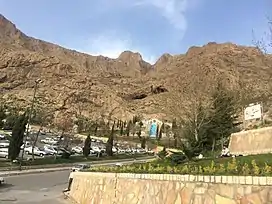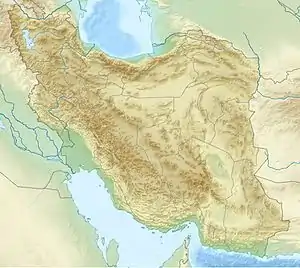| Maiwala | |
|---|---|
 Meywala | |
| Highest point | |
| Elevation | 2,100 m (6,900 ft) |
| Coordinates | 34°24′04″N 47°07′40″E / 34.4010°N 47.1277°E |
| Geography | |
 Maiwala | |
| Parent range | Zagros Mountains |
Maiwala (Persian: میوله, Kurdish:میوله) or Farokhshad (Persian: فرخشاد) is a mountain of the Zagros Mountains, located in western Iran, north of the city of Kermanshah. It is one of the mountains of Paraw range, with an altitude of 2445 above sea level. It is about 5 km long from the Tang-e Malavard at west to Taq-e Kenesht at east. The mountain contains several archaeological caves.
Archaeology
Archaeologists have discovered artifacts of the Paleolithic and historical periods on the southern slopes of the mountain. Three caves were occupied by Neanderthals during the Middle Paleolithic Period including Do-Ashkaft Cave,[1] Malaverd,[2] and Dasht-e Kahou. Archaeological excavations have shown that about forty thousand years ago, Neanderthal humans used natural outcrops of radiolarite or chert around this plain to make stone tools.[3]
Climbing routes
There are several routes to climb up to the peak, the most common of which is called the Sine Sorkh. This route starts from the parking lot above the Kouhestan park located in the west of Taq-e Bostan and reaches the Gav-Chal plain through Pa-Koob route from the foothills of Sineh Sorkh. Then from there it continues to the left ridge and reaches the valley of Niyat. Amoo-Salim Cave, which is hand-carved, is located at the top of this valley. It is fifteen minutes away from this cave to the summit.
Notes
- ↑ Biglari, F. (2004) Preliminary Observations on Middle Paleolithic Raw Material Procurement and Usage in the Kermanshah Plain, the Case of Do-Ashkaft Cave. In T. Stollner, R. Slotta, and A. Vatandoust (eds), Persian Antiques Splendor, mining crafts and archeology in ancient Iran, vol. I, Pp. 130-138, Deutsches Bergbau-Museum Bochum, Bochum
- ↑ Shidrang, Sonia, Alireza Moradi Bistuni, Marjan Mashkour, 2014, Test excavation in the Paleolithic cave site of Malaverd Cave, Kermanshah, Proceedings of the annual Symposium on Archaeological Research in Iran, pp. 283-281, Iranian Center for Archaeological Research, ICHTO. Tehran. (In Persian with English abstract)
- ↑ Biglari, F., (2007) Approvisionnement et utilisation des matières premières au Paléolithique moyen dans la plaine de Kermanshah (Iran) : le cas de la Grotte Do-Ashkaft, Aires d'approvisionnement en matières premières et aires d'approvisionnement en ressources alimentaires, Approche intégrée des comportements. Proceedings of the XV UISPP World Congress (Lisbon, 4–9 September 2006) Vol. 5, pp. 227-239. Edited by Marie-Hélène Moncel, Anne-Marie Moigne, Marta Arzarello and Carlo Peretto. BAR International Series 1725